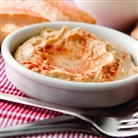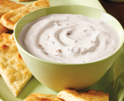Food & Beverage Manufacturing
Dressings, Dips & Sauces
Dressings, dips and sauces serve as embellishments that turn plain food into interesting and satisfying fare. The products often help define cuisines from various regions of the world, as today's packaged salad dressings, dips and sauces are often derived from traditional items created from local or regional ingredients. Dairy products play a significant role in many salad dressings, dips and sauces that consumers seek out for salads, appetizers and snacks, and entrées. Dairy ingredients and products from the United States help product developers keep on-trend with innovation in the dressings, dips and sauces category. Learn more about U.S. dairy products in the Product Section.
Trends in Dressings, Dips & Sauces
 The wide array of dressings, dips and sauces on the market allows consumers to enhance main and side dishes or create the center of a snack, and dairy products are frequently key ingredients. Formulators can suit the needs of increasingly sophisticated consumers who seek to duplicate the tastes and modern versions of comfort foods found in restaurants.
The wide array of dressings, dips and sauces on the market allows consumers to enhance main and side dishes or create the center of a snack, and dairy products are frequently key ingredients. Formulators can suit the needs of increasingly sophisticated consumers who seek to duplicate the tastes and modern versions of comfort foods found in restaurants.
Easy-to-prepare variations of indulgent restaurant offerings such as cheese dips and new spins on ranch and blue cheese dressing flavor profiles and uses are ideal for retail-level adaptation, and cheese is hot. Dressings, dips and sauces also provide protein as well as nutrition and formulation flexibility to meet additional dietary demands driven by health and wellness trends. With its roots in local cuisines around the world, the dressings, dips and sauces category also helps marketers reach consumers with global tastes.
Cheese Is "Hot"
A resurgence in hot cheese dip popularity-particularly fondue, spinach dip and artichoke dip classics-at U.S. casual theme restaurants transfers to demand for convenient packaged products. Once again popular cream cheese, sour cream and parmesan-based dips like spinach and artichoke now also feature cheeses like fontina, pepper jack and sharp cheddar at many U.S. fast casual restaurant chains.
Ranch and blue cheese dressings remain mainstay U.S. salad offerings, yet are also firmly linked to snacks, appetizers and main dish accompaniments, from wings and pizza to French fries and burgers, and even more upscale entrées. A new, spicy twist to the classic creamy buttermilk or, sour cream and sometimes even yogurt-based ranch favorite likewise transfers from menus to packaged goods.
Protein Plus Nutrition
A consumer focus on health and wellness can make every bite count, and items such as protein-fortified dressings, dips and sauces can provide indulgent tastes that also help consumers achieve specific intake goals. When protein intake is spaced evenly throughout the day, it helps maximizes muscle protein synthesis. To get the most benefits, consumers should aim for 20-30 grams of high-quality protein intake at each meal. Diets higher in protein can help promote satiety, curb hunger and preserve lean body mass.
Use of U.S. dairy ingredients-from cheese to whey proteins to yogurt and all other types of dairy products-helps product developers build appetizing and nutritious dressings, dips and sauces that suit consumer demand for indulgent, nourishing products.
In addition to protein, cheeses and cheese ingredients provide flavor and texture, as well as the ability to offer reduced fat creations.Whey protein products provide functional benefits, such as emulsification and water binding, and at the same time, serve to improve appearance and mouthfeel. Yogurt can offer protein and calcium plus the creaminess of dairy with a reduction of fat content.
Global tastes
As consumers around the world are exposed to various cuisines, they consistently demand the ability to replicate the experience at home. Incorporate U.S. dairy ingredients into dressings, dips and sauces to help meet the desire for global tastes. Ingredients like U.S. cheese and yogurt can be blended with indigenous spices, fruits or vegetables from around the world to lend ethnic cuisine flair to the dressings, dips and sauces needed to further enhance meals.
Utilization
Dairy products and ingredients from the United States provide flavor, function and nutrition. The chart below illustrates the benefits of eight common dairy ingredients.
| Butter & Milkfat(Details) | Cheese(Details) | Milk Protein Conc.(Details) | Whey Permeate(Details) | Whey Protein(Details) | Yogurt(Details) | |
|---|---|---|---|---|---|---|
| Appearance |  |
 |
||||
| Creaminess |  |
 |
 |
|||
| Emulsification |  |
|||||
| Fat Reduction |  |
 |
||||
| Flavor |  |
 |
 |
 |
||
| Moutfeel |  |
|||||
| Protein Fortification |  |
|||||
| Shelf-life |  |
|||||
| Sodium Reduction |  |
|||||
| Texture |  |
 |
||||
| Water Binding |  |
 |
||||
| Butter & Milkfat Details | Cheese Details | Milk Protein Details | Permeate Details | Whey Details |
Formulas & Recipes
Access U.S. Dairy Export Council prototype formulations for inspiration on dressings, dips and sauces that feature U.S. dairy ingredients, such as milk proteins, yogurt and cheese.

Protein-powered Curry Hummus
Spicing up widely popular hummus with the power of U.S. dairy ingredients demonstrates how blending dairy proteins with vegetable-based options multiplies the benefits. The addition of high quality milk protein doubles the protein content while complementing the flavor and texture.

VeggieMoo Dumpling with Reduced Sodium Sauce
Vegetable-stuffed dumplings that deliver an excellent source of protein.

